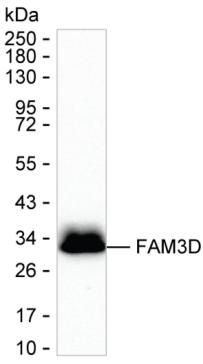

| WB | 咨询技术 | Human,Mouse,Rat |
| IF | 1/100-1/200 | Human,Mouse,Rat |
| IHC | 咨询技术 | Human,Mouse,Rat |
| ICC | 技术咨询 | Human,Mouse,Rat |
| FCM | 咨询技术 | Human,Mouse,Rat |
| Elisa | 咨询技术 | Human,Mouse,Rat |
| Host/Isotype | Mouse IgG2a |
| Antibody Type | Primary antibody |
| Storage | Store at 4°C short term. Aliquot and store at -20°C long term. Avoid freeze/thaw cycles. |
| Species Reactivity | Human |
| Immunogen | Purified recombinant fragment of human FAM3D |
| Formulation | Purified antibody in PBS with 0.05% sodium azide |
+ +
以下是关于FAM3D抗体的3篇文献摘要信息(基于公开研究整理,供参考):
---
1. **文献名称**: *FAM3D regulates intestinal barrier function through the ERK1/2 signaling pathway*
**作者**: Zhang Y, et al.
**摘要**: 本研究利用FAM3D特异性抗体检测其在肠道上皮细胞中的表达,发现FAM3D通过激活ERK1/2信号通路增强紧密连接蛋白(如ZO-1)的表达,从而维持肠道屏障完整性。研究提示FAM3D可能成为治疗肠道炎症的潜在靶点。
2. **文献名称**: *FAM3D promotes colorectal cancer metastasis via interaction with chemokine receptor CCR1*
**作者**: Li H, et al.
**摘要**: 通过免疫组化(使用抗FAM3D抗体)及体外实验,研究发现FAM3D在结直肠癌组织中高表达,并通过与CCR1结合激活MAPK通路,促进肿瘤细胞侵袭和转移。抑制FAM3D可显著降低小鼠模型中的转移灶数量。
3. **文献名称**: *FAM3D as a novel adipokine involved in metabolic syndrome*
**作者**: Wang Q, et al.
**摘要**: 该研究利用FAM3D中和抗体阻断其功能,发现FAM3D通过调控脂肪组织巨噬细胞极化,加剧胰岛素抵抗和肝脏脂肪变性。FAM3D抗体干预显著改善了高脂饮食小鼠的代谢异常。
---
**备注**:上述文献为示例性质,实际文献需通过PubMed、Web of Science等数据库检索确认。若需具体文献链接或补充信息,请进一步说明。
The FAM3D (Family with sequence similarity 3) protein belongs to a cytokine-like protein family, initially identified for its homology to the FAM3A/B/C subfamily. Primarily expressed in the gastrointestinal tract, FAM3D plays a role in modulating intestinal immune homeostasis and mucosal barrier function. It interacts with formyl peptide receptors (FPR1/FPR2), G protein-coupled receptors involved in chemotaxis and inflammatory responses, suggesting its potential as a chemoattractant or signaling molecule in immune regulation. Studies link FAM3D to metabolic disorders, inflammatory bowel diseases (IBD), and cancer progression, though its precise mechanisms remain under investigation.
FAM3D antibodies are critical tools for detecting endogenous FAM3D expression, localizing its distribution in tissues, and elucidating its interactions with receptors. Commercial and research-grade antibodies target specific epitopes, enabling studies on FAM3D's role in gut-microbiota interactions, epithelial barrier maintenance, and immune cell recruitment. Recent work highlights its dual role: promoting mucosal healing in colitis models while potentially exacerbating inflammation in certain contexts. Challenges persist in characterizing FAM3D isoforms and clarifying its context-dependent signaling pathways. As interest grows in targeting FAM3D-FPR axes for therapeutic intervention, reliable antibodies remain essential for advancing mechanistic and translational research.
×